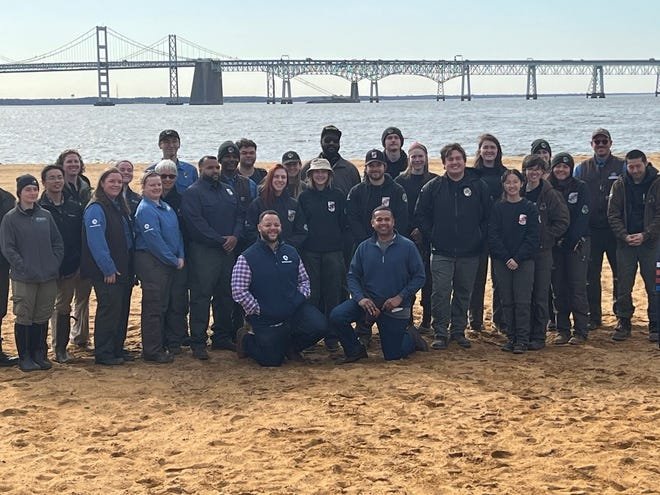A dozen young men standing on a beach with the towering Chesapeake Bay Bridge in the background may not seem grand or monumental, but hearing about the entire group’s work in the state park makes it easy to imagine the Maryland Conservation Corps’ The scale becomes clear.
Forty members and eight crew leaders work on natural resource management projects in state parks across Maryland. On this particular day, three parks benefited from the workforce, according to Corps Chief Sara Marcinak.
Assateague State Park on the Eastern Shore will have 4,000 dune grasses planted in the ground to restore the shoreline and protect against coastal flooding. At Tuckahoe State Park, also on the Shore, a group of less than a dozen people was finishing construction on the last 200 yards of a new trail. The group started the day at Sandy Point State Park’s nature center and took photos near the Bay Bridge, where they worked to clear away invasive plants such as brambles and bitter melons.
In last year’s program, the organization treated more than 7,000 trees in Western Maryland, preserving and protecting them from invasive insects. Staff estimates that over the past decade or so, conservationists have saved more than 60,000 trees across the state.
“I’m so happy to be a part of the program to save Maryland’s natural forests,” said the Corps’ program officer, walking along a muddy path lined with oak trees and protective tree tubes. Annie O’Grady said. Corcoran Environmental Research Area near Sandy Point.
She is one of the veterans of a 40-year-old program managed by the Maryland State Park Service, but for current member Jenny Ha of Hagerstown, the program is part of the National Service Agency, AmeriCorps, which is celebrating its 30th anniversary. ). , is still a new idea.
“It opened up a whole new world of information to me,” said Hagerstown Community College graduate, who learned about the program for 17- to 25-year-olds while working on an environmental mission and started working with the Corps this year. He talked about his experience. Policy classes while in school.
More information: State funding shrinks after Maryland community college enrollment increases. Find out why.
Maryland Conservation Corps members work in state parks
One of Ha’s new experiences growing up was learning how to use a gas-powered chainsaw.
“When I tried chainsaw training for the first time, I was so nervous that I ended up crying,” Ha said. She has an associate’s degree in environmental studies and said she had never spent much time outside. Currently, she is part of a six-person crew at Patapsco Valley State Park in Baltimore and Howard Counties, cleaning trails, testing water quality, and occasionally completing projects throughout other Maryland state parks. are doing.
In an interview at the Sandy Point Nature Center, she credited the team’s efforts in helping her learn how to use a chainsaw months after that first tearful encounter.

“Thanks to their support, I was able to make my first pie cut using a gas-powered chainsaw,” Ha said of the technique used to cut down the tree.
“It was a very ugly pie cut, but it still worked,” she said.
More information: How agritourism boosts Maryland farmers
AmeriCorps CEO calls Maryland unit ‘cutting edge’
When AmeriCorps CEO Michael Smith called Maryland “state-of-the-art,” he wasn’t referring to pie cuts on trees.
He was referring to the new Maryland Office of Service and Civic Innovation, established last year by Democratic Gov. Wes Moore under the leadership of Secretary Paul Monteiro. Decades-old programs like the Maryland Conservation Corps are now under Monteiro’s jurisdiction.
“The advantage of our department is that it’s built on a solid foundation. That foundation is built on programs like the (Maryland Conservation Corps) that we’re visiting today and 30 years of AmeriCorps. It was built by,” Monteiro said.

The state’s newest department chief, who interviewed at Sandy Point less than a year after being chosen to lead, is about halfway through the pilot cohort of the state’s early service year option program for high school graduates. I was at the point.
“Where we’re building, we’re being thoughtful where we’re complementary, we’re not competing,” he said.
More information: Peace Corps ties select Maryland native Wes Moore as first secretary of state
U.S. Climate Change Corps gets head start with Maryland program
A program like the one Ha is part of could be used as a complement to an idea proposed by the president’s administration last September called the American Climate Corps.
The effort to train more than 20,000 Americans in “clean energy, conservation, and climate resiliency skills” already has a head start with programs like the Maryland Conservation Corps.
“Currently, we have approximately 15,000 AmeriCorps members working in a variety of climate-related areas,” Smith said in an interview at the Sandy Point Nature Center. Some Maryland Conservation Corps participants wear shirts with the Corps logo on one sleeve and the AmeriCorps logo on the other sleeve. After he completes one year of service to pay for his education, Segal is awarded his AmeriCorps Education Award by the federal government. That’s a boon for a young man who earns a living wage of about $1,146.07 every other week before taxes.
Review: ‘Maryland leads the nation’: Recruitment requirements receive 500 applications for upcoming programs
At the nature center, Smith spoke to members of the Maryland Conservation Corps about the president’s plan, announced in this month’s State of the Union address, to triple the number of members of the American Climate Corps over the next 10 years. Ta.
“Next year, we might start a Maryland Climate Corps, which is a member of the American Climate Corps. We’re going to put some programs together,” Smith said during an interview.

He noted that 50,000 people had registered their interest in joining America’s Climate Change Corps in the four weeks since its launch last September.
At the state level, the new service program has received nearly twice as many applications as there were slots available last year, and current issues require broader public participation, the secretary said.
“The problem we’re trying to tackle, climate change alone, is going to take everyone,” he said.
Dell’s Chris Adams Profile: Dell.Chris Adams led Eastern Shore delegation and found inspiration in business career in Salisbury
For Ha, her introduction to the Maryland Conservation Corps came not from an AmeriCorps ad or the new Maryland Office of Service and Civic Innovation, but from the Maryland Department of Natural Resources, who came to Hagerstown Community College for Earth Day. This was due to a visit from a staff member. . She said she would “absolutely” recommend the program.
“I really enjoy getting out and meeting people and seeing how my work is helping those around me,” she said.
Dwight A. Weingarten is an investigative reporter who covers the Maryland General Assembly and state issues. Contact him at dweingarten@gannett.com or @DwightWeingart2 on Twitter.

